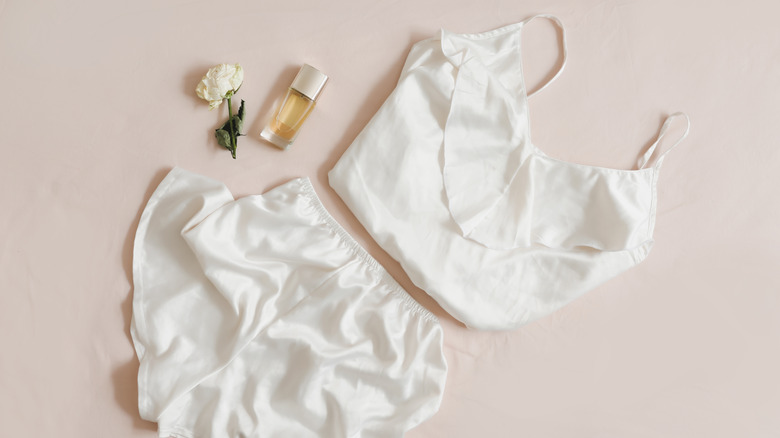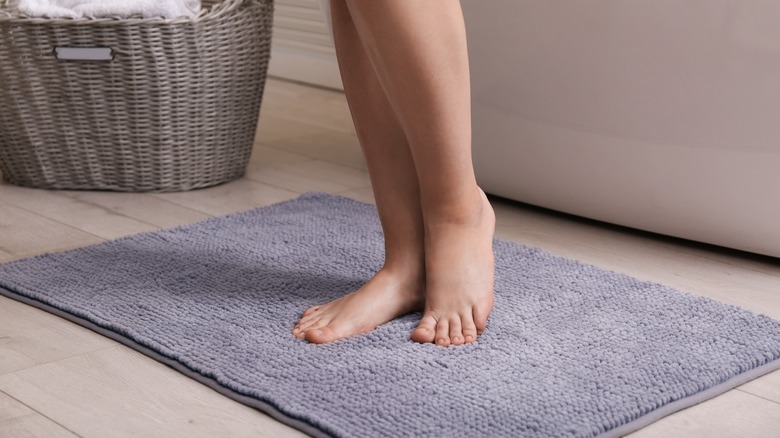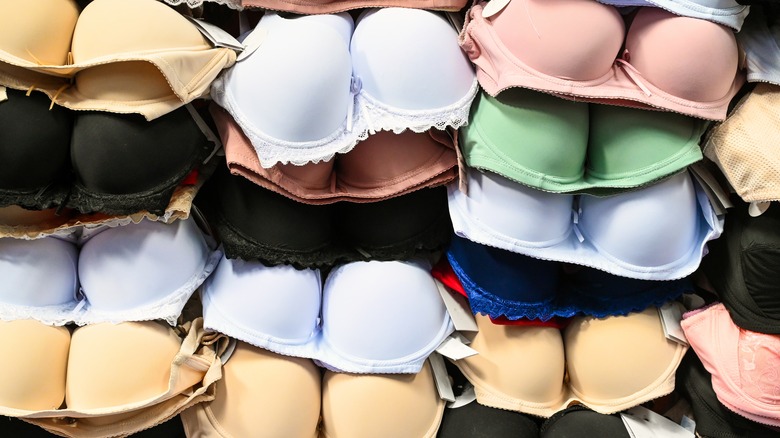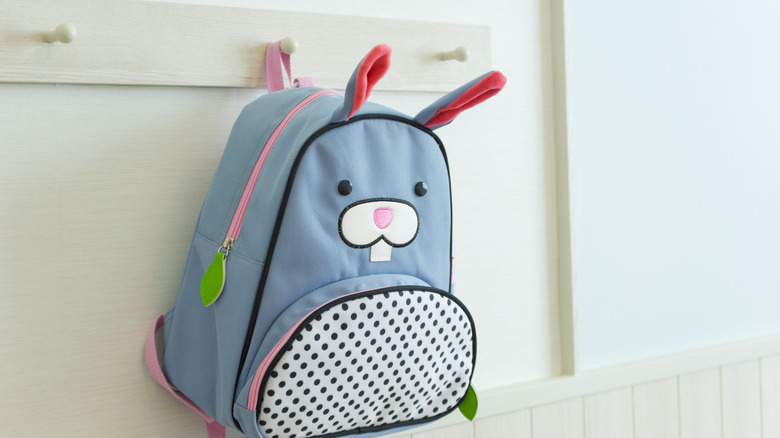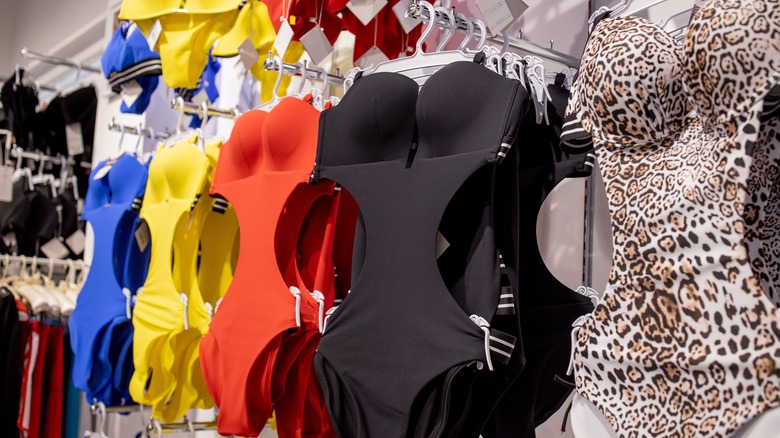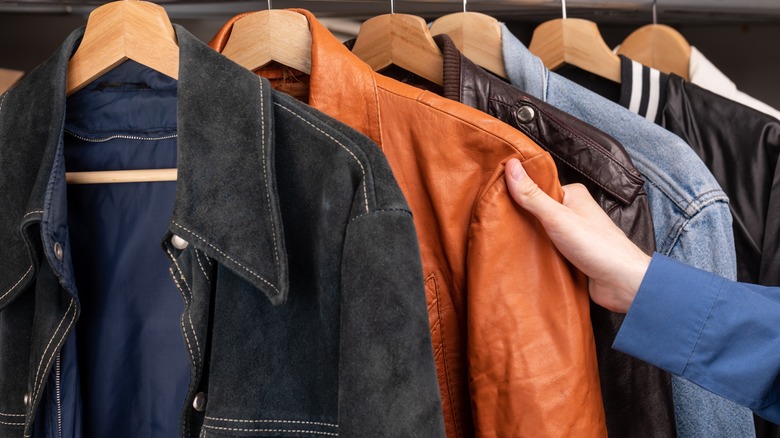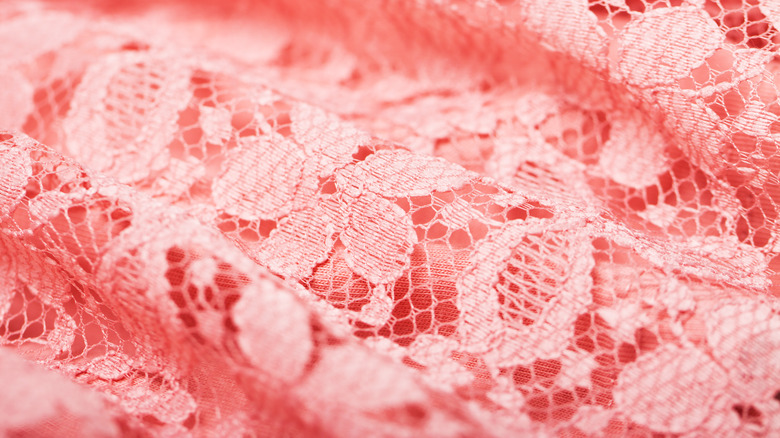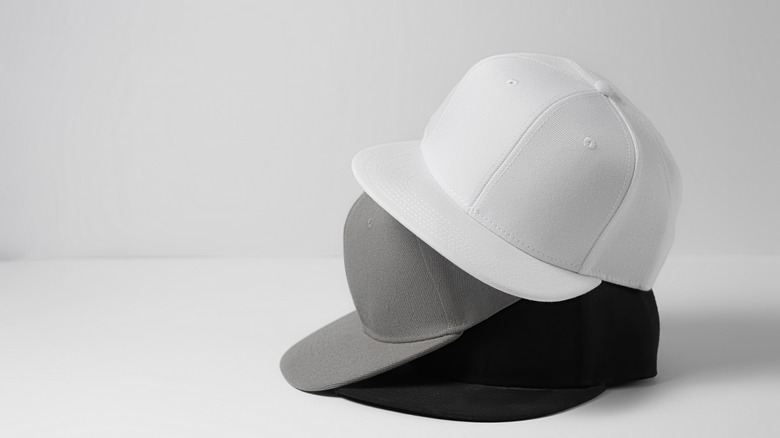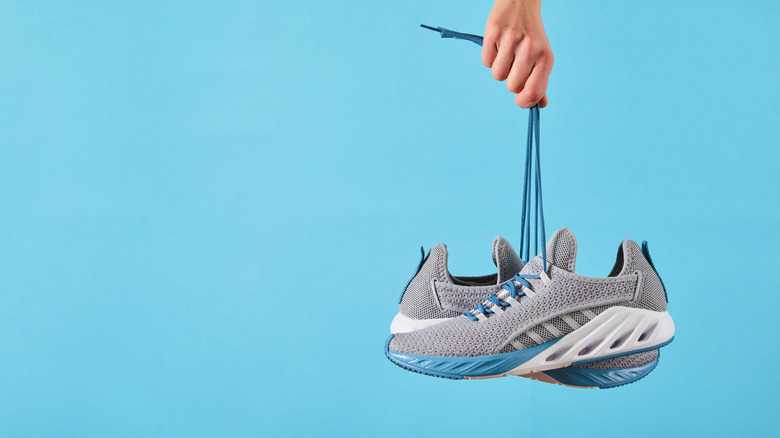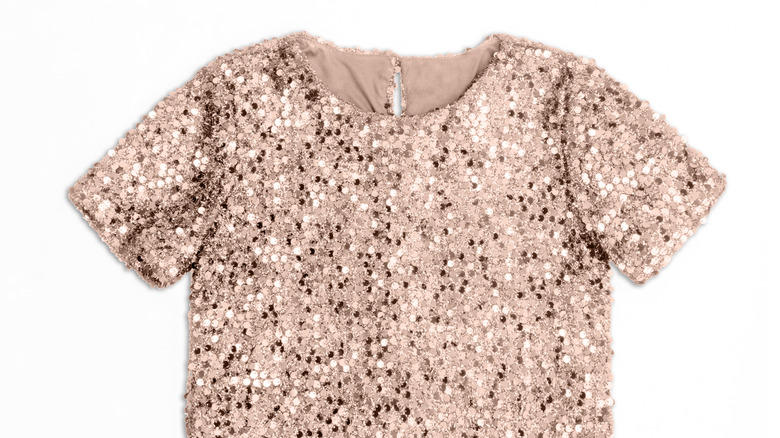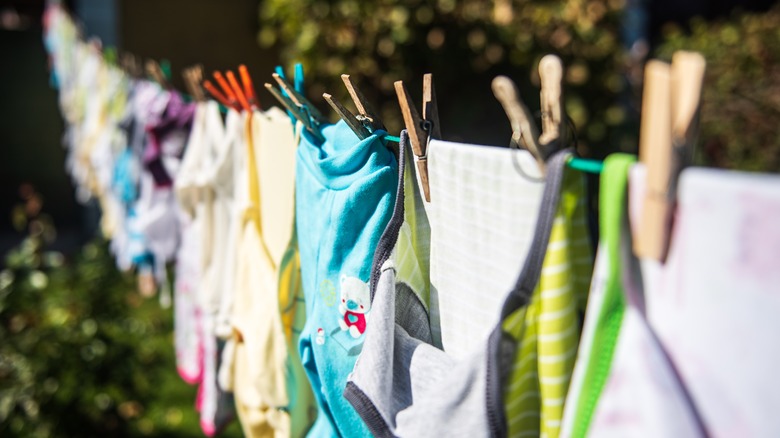Things You Should Never Dry In Your Dryer
Dryers certainly make our lives easier. The ability to take a load of laundry from the washing machine, toss it into the dryer, press a few buttons, and come back about an hour later to dry clothing and linens is something our ancestors could have only dreamed of. However, despite how helpful they can be for many different types of clothing and linens, there are several items that you should never put in the dryer.
If you put the wrong things in the dryer, once the cycle is over and you return to remove your items, you may find yourself pulling out something that has shrunk, torn, or become otherwise damaged. Certain items have the potential to cause damage to other garments or linens in the dryer, or even to the dryer itself. Clearly, you'll want to avoid these scenarios, so read on to learn more about some things you should never attempt to dry in the dryer.
Stuffed animals
A child's stuffed animals — especially their favorite stuffed animals — can get pretty dirty. They are often taken outside, on car trips, or dropped on the floor at home or another location. However, while they can get dirty rather easily, you'll want to take extra care when cleaning them. Many stuffed animals can safely be washed in the washing machine. However, in most cases, you'll want to air-dry them instead of putting them in the dryer.
The main reason behind keeping stuffed animals out of the dryer boils down to safety. The stuffing inside them can introduce too much lint into the machine. If the dryer vent accumulates too much lint, it increases the likelihood of a fire occurring. Even if your stuffed animals don't end up creating a safety hazard, they may not make it out of the dryer in good condition. The higher heat could potentially burn the fur or melt any plastic parts of the animals.
Silk
Anything made from silk is also best left out of the dryer. Silk — along with several other natural fabrics, such as cashmere and wool — is very delicate. If you put it in the dryer, you're risking it getting damaged. It could get snagged on a zipper or button from another item, which would end up ruining your silk garment. Another potential issue with putting silk in the dryer is that the higher heat could cause the fabric to shrink.
If you find yourself in a situation where you have no other option than using the dryer (such as needing the item for immediate use), put the silk item without any potentially abrasive clothes. Set the dryer to an air-only drying cycle for a maximum of 15 minutes. However, the safest choice would be to air-dry your silk garments. Never wring them out; simply roll them in a dry towel to help release some excess moisture. Then, hang them or lay them flat away from direct sunlight.
Rubber-backed mats
If you have rubber-backed mats in your bathrooms, hallways, or entryway, you will want to make sure that they do not get put into the dryer either. While these mats are generally safe to go in the washing machine, the same cannot be said for the dryer. The heat from the dryer can cause the rubber backing to break down. This will decrease the effectiveness of the mat's anti-slip properties and may require you to purchase replacements sooner than would have otherwise been necessary.
The potential damage the dryer can cause to your bath mats and other rubber-backed mats isn't the only reason you should hang-dry these items. Placing mats with rubber backing (or any other items with rubber on them) can increase the chances of a dryer fire. As pieces of the rubber come off with the higher heat of the dryer, they can accumulate inside the dryer vent, eventually causing a clog and, potentially, a fire.
Bras
Bras are made from more delicate fabrics and have a more structured form. The best way to clean and dry them involves staying away from those modern conveniences in the laundry room. In addition to hand-washing being the best option to clean your bras without damaging them, air-drying is the safest way to dry them after they're washed.
If you put your bras in the dryer, its heat is likely to cause materials like elastic and spandex — which are found in nearly all bras — to break down. As you can imagine, your bras won't fit as well or be as supportive if the spandex or elastic materials become stretched out. The tumbling motion of a dryer can also misshape a bra's underwire. Take the few extra minutes you'll need to hand-wash and air-dry your bras. It will be well worth the money you'll be able to save by ensuring that your bras stay in good condition.
Backpacks
Backpacks are another item that can get dirty pretty easily. Between being exposed to the elements, dropped on the dirty ground, and handled with messy hands, it doesn't take a rocket scientist to figure out why your backpack is looking like it has seen better days. If you're looking for the best way to give your backpack a good cleaning and refresh, stay away from the dryer (and also the washer).
Backpacks have lots of different components — like zippers and padded pockets — that could be damaged by the higher temperatures found in a dryer. These materials could end up warping or melting, which could end up ruining your backpack. Instead of using the dryer, try hanging your backpack up to let it air-dry. Be sure to leave all the pockets unzipped and hang it upside down to speed up the drying process. Make sure that the bag is fully dry before storing it to prevent mold growth.
Swimsuits
When you're looking for the best way to dry your swimsuits, you're much better off hanging them up than choosing to stick them in the dryer. Many swimsuits are made using spandex, nylon, or other similarly stretchy fabrics. This fabric type is ideal for swimming as it provides a snug and form-fitting appearance. Putting spandex and nylon in the dryer, however, is not advised. The higher temperatures in the dryer are likely to damage the material, causing it to weaken. Your swimsuit may look stretched or worn the next time you put it on if you use the dryer.
After washing your swimsuit (hand-washing is recommended over using a washing machine for the spandex material as well), hang it up and let it air-dry away from direct sunlight. It is also important to hang your suits on a plastic hanger, not a metal one. Metal hangers or rods have the potential to leave a rust mark on the suit and could also have a negative impact on the swimsuit's shape.
Leather and suede
Your gorgeous leather and suede jackets definitely do not belong in the dryer. More than likely, if you have a leather or suede jacket, you spend a lot of money on it and want to make sure it continues to look its best for years to come. If you put your suede or leather jacket (or even fake leather jacket) in the dryer, the heat can cause some serious damage to the material. One way heat can damage a leather jacket is by causing it to shrink. Once the jacket shrinks, you will not be able to get it back to its original size, so it may not fit as comfortably (or even at all) anymore.
If you repeatedly dry a leather jacket in a dryer, the heat will eventually cause parts of the surface to crack. Again, you will not be able to reverse this damage and will likely be unhappy with how old and worn out it will make your jacket look. Dryers can also have a negative impact on the shape and color of a suede or leather jacket. They can cause the jacket to lose some of its shape and structure, and could also cause it to get discolored.
Workout clothing
Many people may be surprised to learn that activewear requires special care when it comes to washing and drying. You may assume that since these clothes are designed to be worn when you're getting all hot and sweaty, you'd simply be able to toss them in your washer and dryer without thinking. However, that isn't the case. In addition to being careful when washing workout clothes by skipping the fabric softener, only washing workout gear with like materials, and protecting the fabrics by turning them inside out before washing, you should also be air-drying these items.
Activewear is made from synthetic fibers. These items often also include elastic bands. The dryer is likely to stretch the fabrics out or impact their ability to effectively wick moisture away from your body to keep you cooler during a workout. The best way to dry your active gear is to hang it up on a plastic hanger or clothesline.
Lace
If you have a lace blouse, dress, nightgown, or underwear, then you probably already understand how delicate the material is. Lace features an open web design, meaning that there is space between the different sections of thread. This intricate design is what makes it so beautiful, but it is also what makes it very delicate and easy to damage. If you put lace in the dryer, it is possible that something will get caught in one of the little openings between the fabrics and cause it to tear or snag. Moreover, a dryer's high heat can also damage the more delicate threads used for the fabric. Over time, they'll weaken and may eventually break.
The best way to dry most lace items is to lay them flat. Hanging them up when wet can put too much strain on the fabric and may cause it to stretch out. Before laying the item flat to dry, you can place it on a towel and roll the towel up to remove excess water. Double-check the care label before washing or drying anything made from lace. Some manufacturers recommend dry cleaning for their garments.
Baseball caps
Whether you only grab a baseball cap to wear on occasion or it is a staple of your wardrobe, there is going to come a time when it needs to get cleaned up. So, you may be wondering whether you can put it in the dryer after washing it. The best choice when drying these hats is to keep them away from the laundry machine. As we've mentioned several times now, a dryer's high heat can damage a lot of items, and baseball caps are no exception. The higher temperatures can distort the shape of the caps, messing up the bill or even how the hat will fit on your head. Always air-dry your baseball caps. You can even go a step further to help protect the shape by bunching up a clean towel and putting it inside the hat. This will help to keep it from sagging and losing its shape as it sits out and dries.
Tennis shoes
Fortunately, many tennis shoes are easy to clean in the washing machine. However, after you wash your tennis shoes — even those that the manufacturer recommends cleaning in the washer — make sure you do not try to put them in the dryer. The rubber soles on tennis shoes are attached to the canvas, leather, or other materials with glue. If you put the shoes in the dryer, it could damage this glue, threatening the structural integrity of the shoes.
Moreover, putting your shoes in the dryer may also cause them to shrink or warp. This will clearly have a negative impact on how well the shoes fit you, how comfortable they feel, and, ultimately, whether you're even able to use them anymore. Always air-dry your shoes — and make sure that they are able to fully dry to avoid giving bacteria a moist environment in which they can dry. Roll up a few hand towels or washcloths and put them inside the shoes as they dry to help maintain their shape. If you need to wear your tennis shoes before they have had a chance to dry fully, consider using a blow-dryer to help get them ready a bit more quickly.
Any clothing with embellishments
Clothing with embellishments — such as sequins, beads, or tassels — should also be kept out of the dryer. These accessories are often attached to the garment with glue. When put in a hot dryer, the glue may melt, causing the embellishments to fall off or move out of place. Besides melting the glue, the dryer could end up melting the delicate sequins or beads themselves. In addition to the damage it will cause to your favorite items, melted plastic inside the dryer will not be good for it.
Even if the glue, sequins, or beads manage to withstand the hotter temperatures, there is an additional risk to consider: the tumbling motion of the dryer could cause these embellishments to get caught on another item. This could cause the embellishments to tear off or may snag another item in your dryer. Air-drying is the best solution to protect your sequined or beaded clothing or accessories.
Any items with a label that recommends air drying
When doing laundry, it is essential to read the care labels. These tags include recommendations from the clothing manufacturer regarding the best way to wash and dry the item to preserve and protect it against damage. Air-drying is much gentler on clothing than putting it in the dryer. Beyond the higher heat of the dryer that can damage some materials, dryers also tumble clothes, causing the fabrics to rub against each other throughout the cycle.
Some clothing care labels may specify whether the item should be hung up to dry or laid flat to dry, while others may simply state that it should be air-dried. If the care label recommends laying an item flat to dry, it is important to follow those guidelines. Wet clothes are heavy, and the added weight can cause cashmere, wool, and other materials to stretch out if they are hung. The neckline of your favorite sweater may get pulled down too far or the shoulder area may become too stretched that it doesn't fit properly anymore if you hang it up instead of laying it flat to dry. Lighter fabrics that won't stretch should be safe to hang on a plastic hanger or clothesline to dry, unless otherwise specified by the manufacturer.


